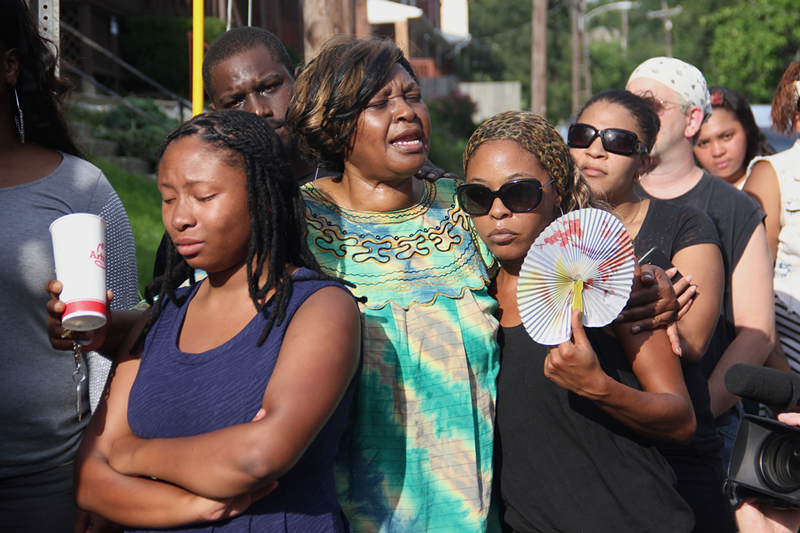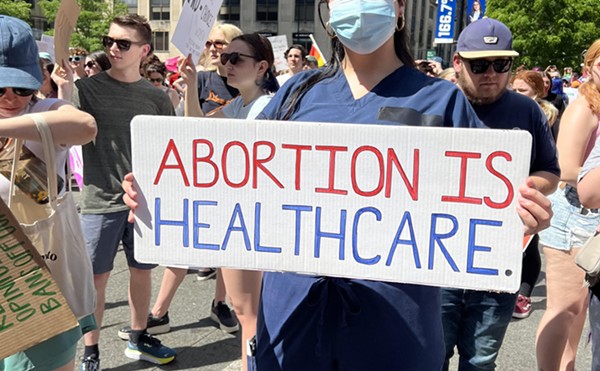
On July 20, more than 100 mourners gathered in the small, isolated section of Mount Auburn where Samuel Dubose died the previous day. A memorial with drums, cards and balloons decorated the stop sign at the corner of Rice and Valencia streets.
Some wept, while others shouted for answers as to why University of Cincinnati police officer Ray Tensing shot the unarmed 43-year-old during a traffic stop just over 24 hours earlier.
“I want to thank each and every person who’s here today standing up for my son,” his mother, Audrey Dubose, said at the vigil as other family and friends gathered around her. “They loved him. They cared for him. They know he was full of love. Lord, don’t let this go unaddressed. Don’t let them just murder my son.”
So far, there are more questions than answers about Dubose’s shooting. UC law enforcement officials said at a July 20 news conference that the officers involved opted to exercise an option in their contract that allows them 48 hours before making statements about the incident. As of CityBeat’s press time, no statements from officers had been released. Meanwhile, Dubose’s family says they have doubts about the official story around what happened during the traffic stop, which was made over a missing front license plate.
The incident has reignited a long, tense conversation around police use of force against people of color in Cincinnati and beyond.
Activists point to the incident as yet another example of the systemic injustices blacks face from law enforcement, a subject that has garnered a great deal of national attention over the past year following the police shooting of 19-year-old Michael Brown in Ferguson, Mo., last summer and subsequent unrest there. Since then, other police shootings have garnered national attention as well, including the shooting deaths of 12-year-old Tamir Rice in Cleveland and John Crawford III in Beavercreek.
As these issues have played out across the country, Cincinnati has been touted as a model for police reform, which it instituted following the 2001 police shooting of Timothy Thomas in Over-the-Rhine and subsequent unrest in that community. Thirty-one people have died at the hands of police since 2000 in Cincinnati, including three high-profile deaths this year. Some of those, including the June shooting of 21-year-old Trepierre Hummons, have come after suspects have fired on officers. Hummons shot and killed officer Sonny Kim before police shot him. In other cases, however, such as Dubose’s, those killed by police have been unarmed.
According to UC Police Chief Jason Goodrich, who spoke at the July 20 news conference, Officer Tensing had seen Dubose driving without a front license plate down Vine Street at McMillan Avenue near UC’s campus and followed him half a mile, pulling him over at the corner of Thill and Rice streets. Dubose turned off the car and removed his keys from the ignition, Goodrich said, but did not present his license when Tensing asked for it because it had been suspended in January. Dubose handed the officer an unopened bottle. Tensing asked Dubose to exit the car, but Dubose refused.
Tensing tried to open the car door, but Dubose struggled to keep it closed, at which point, Goodrich said, Dubose put his keys back in the car’s ignition and started it, then began to drive off. As the car began moving, Tensing shot Dubose once in the head, killing him, authorities say. The car continued driving, knocking Tensing to the ground before crashing more than a block away at Rice and Valencia streets. The officer suffered bruises on his legs and spent a brief time at the hospital. The official version of the incident recalls the tragic 2000 death of Cincinnati police officer Kevin Crayon, who died after he was dragged by a car he was attempting to stop driven by a 12-year-old.
Goodrich did not comment on whether the officer had reached into the car or the exact nature and intensity of the struggle. Two other university officers were also at the scene, and Cincinnati police responded shortly after the shooting. The UC Public Safety Office has not responded to CityBeat’s public records requests for the officers’ personnel files, incident reports, body camera videos and other documentation of the incident.
At times, the news conference became tense. Dubose’s family says they believe that Tensing might not have been in danger at the time and that video collected from police body cameras and other sources at the scene might show a different scenario than the one sketched by police officials. Beyond that, they question how a routine traffic stop could spiral out of control so quickly.
“What threat was there so that the officer pulled out his firearm?” asked Dubose’s daughter-in-law NaKiima Reid. “My question is, in any circumstance, when is death justifiable for a misdemeanor? This is purely a homicide.”
Dubose’s mother says her son was never a fighter. She acknowledges his long record with the law, but points out his offenses were almost entirely minor and nonviolent. Dubose has faced about 75 low-level charges in Hamilton County courts, mostly for marijuana and traffic offenses. A more serious assault charge against Dubose was dismissed last year.
“My son was not a violent person,” she said. “He got stopped a lot, but he never tried to fight.”
Dubose stressed her son’s positive attributes — he was a well-respected musician and producer in the community, according to friends and family. Dubose had gotten engaged last week, family members say, and was a father to 13 children, some of whom attended the vigil.
“He was just driving home,” said Samuel Vincent Ramon Dubose, one of his children, as he fought back tears. “He didn’t do nothing bad. He didn’t do nothing at all.”
State Senator Cecil Thomas attended the news conference and the vigil, speaking with Dubose’s family and urging patience as the investigation continues. “All those questions have to be answered,” he said. “But for now, I would rather they have this press conference than wait.”
Chief Goodrich says it’s not uncommon for university police to patrol areas outside of campus. A mutual relationship between UC’s department and Cincinnati Police gives UC officers the same powers as the city’s police in cases in which there is a compelling reason for officers to act off-campus. A stipulation of the mutual agreement between CPD and university police is that CPD must be notified as soon as possible about off-campus stops. Goodrich says Cincinnati Police were notified about the stop “about the time the stop occurred.”
A CPD incident report, however, begins at 6:33 p.m. with the comment, “SHOOTING — VICTIM WITH HEAD INJ.” It is unclear if records of an earlier dispatch exist. The CPD records department says the incident report is the only document the department has made public at this point.
Goodrich said the traffic stop was initiated at the corner of Vine Street and McMillan, near campus, and only ended a half mile from the university because that’s where Dubose pulled over.
“The initial violation was observed in what would typically be considered our area,” he said. “The presence of the university police department in that area has been commonly accepted and welcomed for at least a decade, probably more.”
But previous statements from former interim UC Police Chief Jeff Corcoran paint a picture of increased involvement in the communities surrounding the university.
“It used to be we were responsible for the campus,” Corcoran said in a 2011 story by the Associated Press. “Now there’s an expectation, I think, especially with parents, but to a large extent among students, that we’re also responsible for these areas off campus.”
Dubose’s death isn’t the first police-involved death for the university’s police force. In August 2011, 18-year-old UC student Everette Howard, Jr. died after officer Richard Haas tasered him. UC officials said Howard didn’t comply to a direct order from officers. The family sued, saying the use of force was unwarranted, and a year later won a $2-million settlement against the university.
UC police were also involved in the fatal 1997 shooting of Lorenzo Collins, a mentally ill man who was surrounded by 15 UC and CPD officers while brandishing a brick. Collins was shot by both CPD and UC police. Though a grand jury failed to indict officers in that shooting, Collins’ family was awarded $200,000 in a civil wrongful death suit.
Hamilton County Prosecutor Joe Deters announced July 21 that his office is holding evidence, including video of the incident, until an investigation led by the Cincinnati Police Department is concluded. City of Cincinnati officials vowed that the search for the truth about Dubose’s death would be exhaustive and fair.
“This is a serious situation and I will do everything necessary to ensure the investigation is handled as such,” City Manager Harry Black said in a statement. “The process of finding out exactly what happened will be thorough, complete and transparent.”
Meanwhile, a UC student group organized a rally July 21 outside the university’s public safety office, calling for more answers about the shooting, and Dubose’s family has vowed to continue pressing for information about his death. ©





